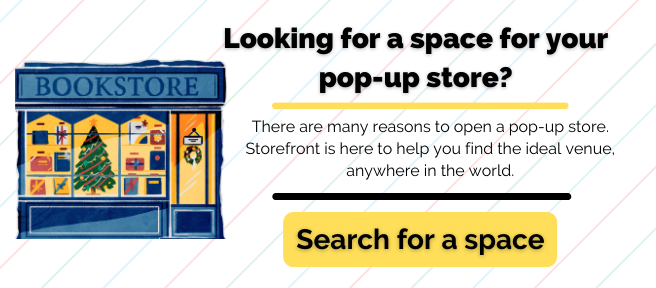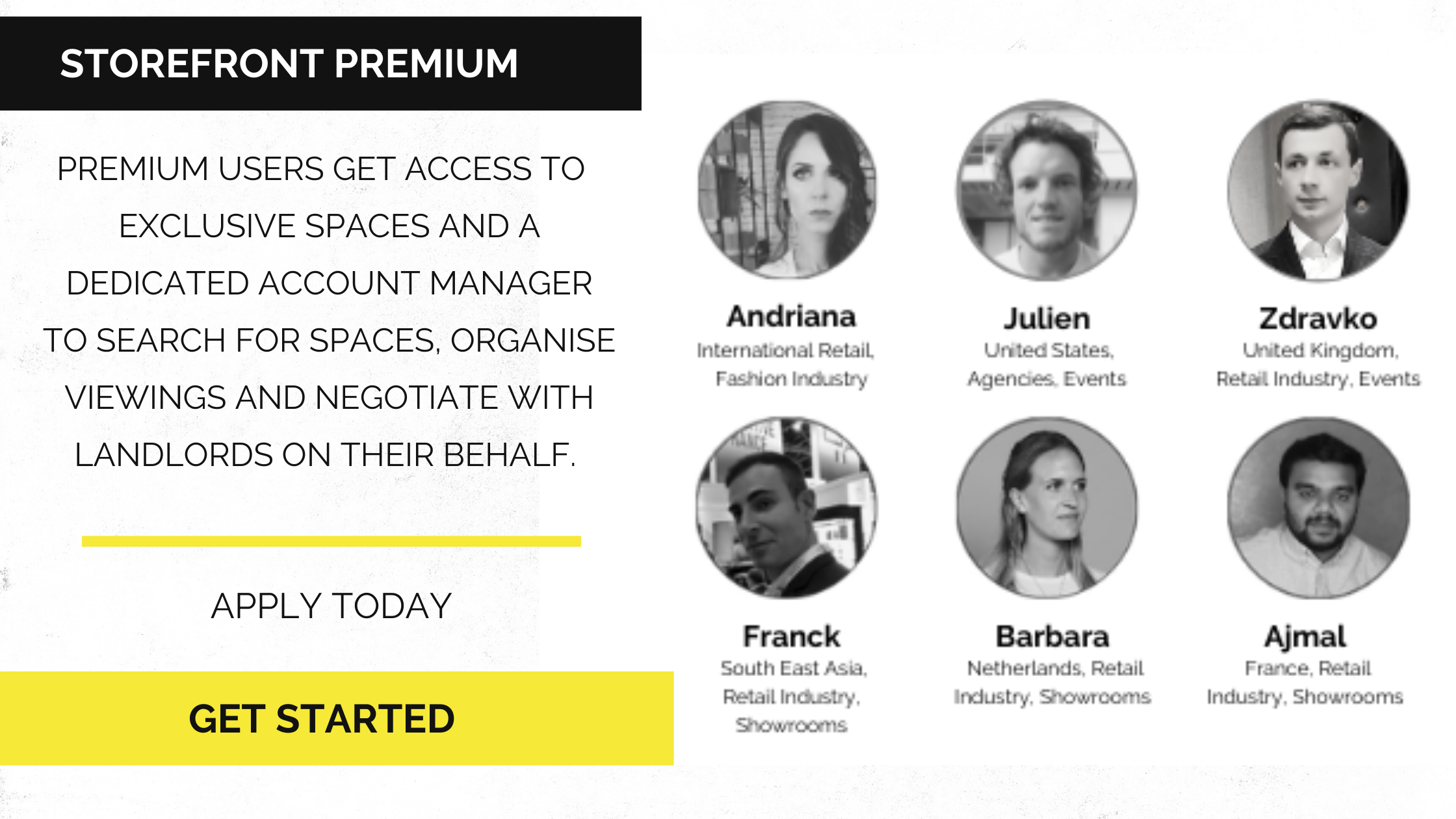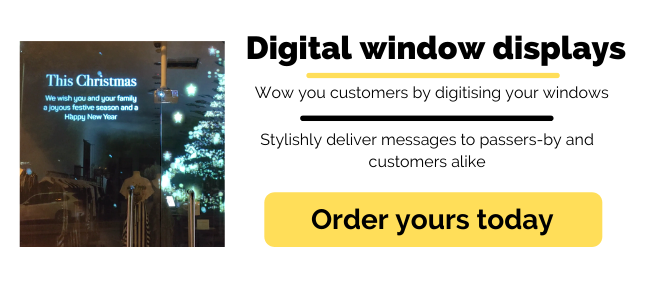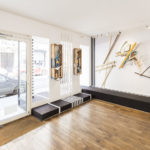What is a pop-up shop? Everything you need to know to try short-term retail > How to set up a pop-up shop in 6 stages. Set yourself up for success with this handy checklist
How to set up a pop-up shop, How to do a pop-up shop, or How to open a pop-up shop is the most frequent questions we get asked. Setting up a bricks and mortar pop-up store is a lot of work, and while Storefront is the expert in finding venues for pop-up shops, many other factors are equally important.
We’ve prepared the checklist below to help anyone contemplating running a pop-up shop. It takes the form of a list of questions and statements we recommend you consider before you go any further. Make sure you have considered every aspect and have an idea of how to answer most of them.
It won’t all be relevant to you, as so much of it depends on the specifics of your business, your product and what you’re trying to achieve with a pop-up shop. Nevertheless, we hope you find it useful, and if you have any questions at all, please don’t hesitate to get in touch.
We have broken the entire pop-up store journey into six phases; Planning, Getting Started, Ready for Opening, Operation, Closing and Evaluation.
Prepare for your pop-up store
Are you considering opening a pop-up store? Pop-up stores can be a great way to test out a new retail location, generate buzz for your brand, and boost sales. But before you open your doors, there are a few things you need to do to prepare.
In this blog post, we’ll share tips on how to prepare for your pop-up store, including choosing the right location, creating a standout design, and promoting your event. By following these tips, you’ll be sure to make your pop-up store a success.
Stage 1. Planning
Read More: 6 Tips for Planning a Pop-Up Store
- Have a clear objective – what are you trying to achieve with your pop-up shop?
This first item to tackle is probably the most important. Much of the success of your pop-up shop will depend on how stringent and thorough you are at the planning stage.
To do this properly, you need to clearly understand what you are trying to achieve and what it means for your business. In short, what’s your objective?
Are you looking to build your brand? Get new business? Simply test out your products. Raise awareness? Launch a new product? See what it’s like to have a retail or physical presence?
These are all valid objectives and ones many brands have employed before. Just make sure you know what you’re trying to achieve.
A clear understanding of your objective will help you to accurately complete the rest of your planning. Every person involved in the project should know what the objective is.
Keep your objective in mind when considering the following:
- Budget – How much are you able or willing to spend on a pop-up shop to achieve those goals? Budget will play a huge factor in the rest of your plans. You need to be clear about how much you will spend and what you will get back from it.
- Retail Location – Which country, city and neighborhood provide the best option for your business to achieve your goal? Consider footfall and foot traffic, as well as branding and behavior. Where is your ideal audience most likely to be? What kind of person are they?
Read More: How to Choose The Best Destination For Your Next Pop-Up Store?
- Venue – what does the retail space need to have for you to achieve your goals?
- What utilities do you need? (wi-fi, video equipment, or kitchen space, for example) and how you will use them. Most spaces include this in the price but always double-check.
- Will you need storage? Will you need storage in the store, or will you need storage elsewhere?
- Design – how do you want your pop-up store to look? What will most appeal to potential customers and foot traffic alike?
Read More: 16 Amazing Fitting Room Design Tips for Pop-Up Stores
- Digital and offline synchronization – understand how you’re going to couple your offline sales with your digital sales and e-commerce setup. Is it the same customer base currently standing at the till who ordered something online last week?
- How are you going to promote it? Making people aware of your pop-up store is very important as you may not be able to rely solely on footfall (depending on where you’re located).
- Success? You should have an understanding of what success will look like and what factors will affect it. Is it a revenue target? A customer engagement target? The number of social media likes or retail sales? Online sales?
Set up your pop-up store
A pop-up shop is a great way to test the waters for your retail business. It’s a temporary space that allows you to see if there’s a demand for your product or service in a particular location. If you’re thinking of setting up a pop-up shop, there are a few things you need to do to get started.
There are many benefits to setting up a pop-up store, including the ability to reach a new customer base and test out a new product or service. However, before you can start reaping the rewards, you need to set up your pop-up store. This can be daunting, but with our tips, you’ll be ready to open your doors in no time.
Stage 2. Getting started
- Make sure you’re aware of what’s happening around your venue for your stay. If building or road works are planned, you need to know about it and decide whether it’ll impact your ability to achieve your goal. What will the traffic outside be like? What do the shops around you look like? Are they having work done?
- Pick your temporary location or physical location and book your venue. You can do this through the Storefront platform or work with our concierge team, who can liaise with the landlord for you. They’re all retail experts, so feel free to lean on their expertise.
Read More: How Long Should The Pop-Up Shop Last?
- Don’t forget to make sure your plans work with the landlord’s requirements – check there isn’t a limit on retail operating hours or similar that could scupper your plans
- Insurance – better safe than sorry.
- Get any permits or licenses in order. This will vary on the nature of your pop-up store, the nature of your retail and the country/city you are in. Do your research ahead of time.
- Visit your pop-up space and figure out its configuration, so you always have a clear picture in your mind.
- What will your window displays look like? How will you get your message across?
- You may need to purchase or hire equipment such as fixtures, furniture, lights and decorations.
- Hire your staff. Staff are incredibly important. Successful pop-up shops are staffed by enagaing, exuberant and on brand staff. They are the face of your brand so it is critical that you get people you trust to engage with your consumers. Don’t scrimp on this one, get people with retail or shopping experience or people you can trust.
- Start marketing. It is never too early to start drumming up buzz for your pop-up shop. Awareness is important.
Read More: How To Market Your Pop-Up Store
- How will you take payments? If you want people in and shopping you’ll need a foolproof and secure way of taking card payments. There are a number of payment systems out there that sync directly with the WiFi and can be securely run from a mobile phone. If you’re planning a ticketed event, select a solution to sell and scan tickets.
Stage 3. Ready for opening
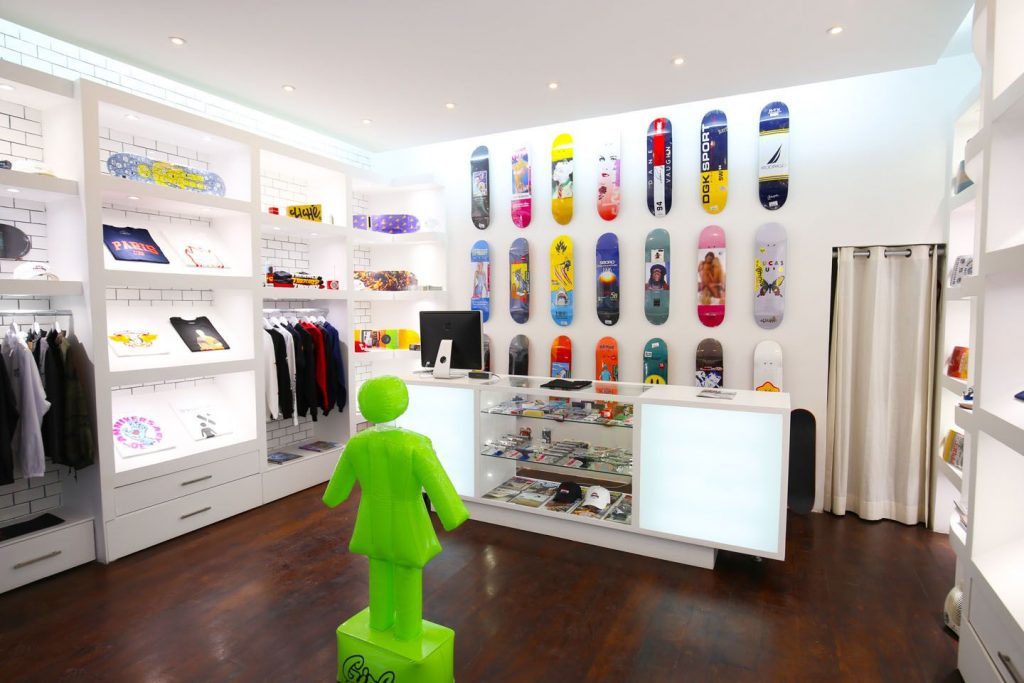
- Determine your pop-up store’s policies, such as whether animals are allowed and if only customers can use your restrooms. What happens if a shopper becomes unwell?
- Do something to draw visitors in – when you’re planning your marketing, ensure you include how you’re getting people walking past to come in.
- Give away swag. People love free stuff so consider giving away branded merchandise and make sure you plan it and order it well in advance. It doesn’t have to be your actual products. Think t-shirts, pens, stickers, mugs, chargers, umbrellas, batteries… Be as creative as you can – just bear in mind your objective.
- Events. Are you going to hold events during your pop up? They can be a great way to mobilise your customers and deliver impactful experiences. Try and tie them into your products and your brand.
- Stay in touch with your landlord. They are a person who probably has a fair amount of experience using their retail space. Keep them up to date with your plans and how it’s going. They want you to be successful and may be able to help.
- Test everything, from the lights and music to payment and other online systems.
- Are you going to have a grand opening? Think about whether you’re going to start with a bang. Retail relies heavily on the experience you can deliver. An opening event is a great excuse to put on a show. Wrap it up with your marketing efforts.
Stage 4. Operation
- Opening and shopper hours. When are you going to be open? Make these decisions early and communicate them as consistently as possible.
- Determine employee policies and think about how you can engage and motivate your staff. A happy employee will give your consumers a much greater level of service.
- Cleaning – keeping the store neat and tidy is important, and you need to decide whether it’s something staff can cover or if you need to look into a separate cleaning service.
- Maintenance and technical support. Make sure you have an understanding of how your kit works and put a process in place in case something goes wrong. Do you need contingencies for taking payments in case you go offline? Do you have a person you can call in case of technical issues?
- How are you going to say goodbye? A big party? An email? Make sure it is in line with your overall objective. Your last few days or hours are a great opportunity to give it one final push to engage with consumers.
Stage 5. Closing
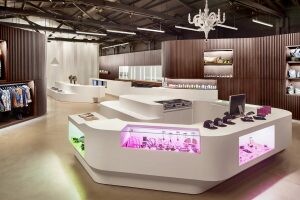
- Clean up the space. You will need to ensure you leave enough time and energy to clean up the space. If you’ve created quite a mess, consider a private cleaning firm to come in and clean up after you. You’ll want to leave it in as good a state as you found it.
- Dispose of rubbish responsibly. Commercial waste needs to be disposed of in line with local regulations. Again, there are services you can look into that provide all-in-one solutions.
- Take down and disassemble all displays, furniture, banners, signs, and any furniture you customize for your pop-up. Can you recycle them for future projects?
- Return keys to the landlord. Make sure that any equipment provided with your rental ends back in the right hands.
Stage 6. Evaluation and analysis
- Measure your performance against the objectives and any benchmarks you created.
- Determine what your overall success metrics were. If it was social media engagement, what was the impact of the pop-up? How many shares did you get? New followers? If it was sales, then what was your net revenue? New customers? How many sign-ups did you receive?
- Promote the success of your project internally in your company and externally. Share your good work with other brands and customers.
- Reach out to your customers and anyone who helped the project to say thank you – including the landlord.
- Ask yourself: Would you do it again? was the location right? What would you do differently next time?
- Learn from any mistakes, and take note of the elements that worked so you can go bigger and better next time around.
Conclusion
In conclusion, Pop-up stores are a wonderful way for businesses to attract new customers, while also promoting brand awareness. While they are easy to set up, there are some important considerations that need to be made.
As always, feel free to let us know if you have any questions about booking a space or planning your pop-up store. We’re happy to help.
You can always contact us.

